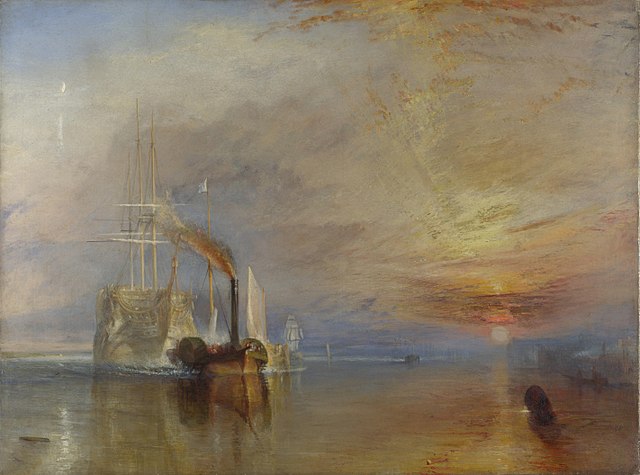
Martin Goodson
On the Contemplation of Nature
Views on 'Nature' vary from one culture to another. What does this mean to our understanding of 'True Nature' in Zen?

J. M. W. Turner, The Fighting Téméraire tugged to her last Berth to be broken up, 1839... By J. M. W. Turner
National Gallery of Art, Public Domain, https://commons.wikimedia.org/w/index.php?curid=37144597
In Western cosmology there is a divide between human and nature going right back to the beginning of Genesis, when God created man after the rest of creation and then gave Adam power over the earth, to name its inhabitants and to use them as his instruments, as he pleases.
We are special in the eyes of God; even when Adam and Eve fell from Paradise through disobedience God then sent his son to redeem humanity. By this time the world was the place of the devil.
In Christian Europe, nature was to be feared. In medieval bestiaries the vices of this world were symbolised by various animals, pigs for greed, foxes for slyness, wolves for predation. Even today, to call someone a ‘dog’, ‘pig’ or a ‘cow’ is deeply offensive. Even that neo-pagan appropriation, the 'Green Man', a foliated human head often found on medieval churches, is probably not a pagan survival into the Christian era. Historians think it is a warning; the portrayal of the dangers for the man who allows his ‘natural’ impulses to get the better of him - think King Nebuchadnezzar.
In Europe our views towards nature began to change slightly with the advent of Romanticism, first in Germany and then in Britain. Attitudes changed, and now the public wanted to go to the wild places away from the grime of the urban environment and this attitude is still with us today.
However, the divide is still there. In the past, nature was to be tamed, and by force, if necessary. Now, ‘she’ is to be saved like the proverbial damsel in distress by the shining knight of humanity. The result of this divide is that whether damned or to be saved it is human agency that is always to be the deciding factor.
In non-European cultures, the worldview is very different. Joseph Campbell, the American mythologist, had a realisation of this when he first visited Japan. He saw a land that knew nothing of the Fall, where Nature itself is divine and humans are to be in alignment with Nature because that is what we are.
In Zen, our practice is to see into the True Nature of our own being and to recognise this nature as being one with all Nature. But as we see, the way we conceive of nature can vary culture to culture. This can show itself in training when we first come into contact with the darker side of the human psyche - for some the encounter with the power symbolised by the ten bull pictures can feel ‘evil’ or ‘devilish’ rather than being some natural force. There is a sense that ‘I’ must change this nature in order to see ‘my’ true nature! But this seeing is like the man who mistakes a string of jewels for a snake as he walks in the half-light.
During this time of lockdown we can go out for walks, and during this exercise we can use the time for contemplation and for seeing differently.
In order to contemplate, first we must empty out the heart. This is like the full cup that has to be cleaned out before it can receive anything else. So, before we go out take ten minutes to sit quietly in Zazen. Allow the heart to settle down a bit, then go out for that walk.
Go right into looking around…
Open up into the act of listening…
However, do not just stick with the bare sights and sounds; otherwise this can again become ‘I’ deciding what is true to the seeing and hearing and what is false.
As we move through the nearby places, we might notice the architecture of the buildings, we may notice where the old has been taken down and the new erected. Maybe there is a date of when a building was constructed or we notice the tree lined avenue that is a century old. All this is the meaning of the place that comes into us and is also part of our journey. Allow this way of seeing to belong to the place, rather than censoring the impressions. In this way the journey is both and inward as well as outward experience but like the passing scenery the inward impressions arise and pass away without grasping.
There is no need to grasp or follow any of the thoughts, memories, or realisations that flow through as our legs carry us on our journey.
Keep making an effort to give yourself into this journey and to stay with what appears outwardly and inwardly without interfering, as much as possible.
When finally the journey ends, what was it like this time? Was there a sense of coherence between the outer world and the inner world? Is there a sense now of a continuation between the nature of one and the nature of the other?
………………………..




